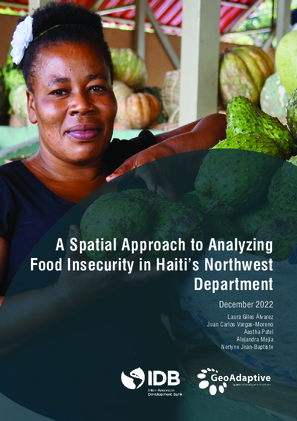A Spatial Approach to Analyzing Food Insecurity in Haiti’s Northwest Department
Date
Dec 2022
This study presents an analysis of food insecurity and its underlying factors in the Northwest department in Haiti. This department is one of Haitis departments most vulnerable to and affected by food insecurity,
with 55 percent of the population in need of urgent assistance (IPC 2022). Using the Integrated Food Security Phase Classification (IPC) and the Inter-American Banks (IDB) Food Security Framework (IDB 2018), this paper presents a geospatial analysis, complemented by a review of other socioeconomic factors, to provide insights on what is driving this trend and what are the most urgent areas to address. The results show that a decline in domestic production which has been hampered by inadequate infrastructure and financing, insecurity, and natural disasters has occurred alongside international supply chain disruptions, that have affected imports together with stalling aid receipts. Taken together, these factors are having a negative effect on the availability of food. Supply constraints, mobility restrictions, price shocks, and risks to sustained income are also having a negative impact on access to food. Challenges to access potable water and sanitation infrastructure, as well as insufficient diversity in diets, also hinder food utilization, described as the availability of quality food required to attain adequate nutritional status. Moreover, food stability is not guaranteed because of issues related to the regions natural endowments, insufficient irrigation infrastructure, vulnerability to climate shocks, price fluctuations, and insecurity. Based on these findings, this paper recommends 23 actions to expand access to basic services, promote adequate nutrition, support productive and sustainable agriculture, and increase resilience to shocks and stresses. Most importantly, rolling out these measures in an effective way will require a coordinated approach at all administrative levels of the state, from local to national, with the private sector and the donor community.
with 55 percent of the population in need of urgent assistance (IPC 2022). Using the Integrated Food Security Phase Classification (IPC) and the Inter-American Banks (IDB) Food Security Framework (IDB 2018), this paper presents a geospatial analysis, complemented by a review of other socioeconomic factors, to provide insights on what is driving this trend and what are the most urgent areas to address. The results show that a decline in domestic production which has been hampered by inadequate infrastructure and financing, insecurity, and natural disasters has occurred alongside international supply chain disruptions, that have affected imports together with stalling aid receipts. Taken together, these factors are having a negative effect on the availability of food. Supply constraints, mobility restrictions, price shocks, and risks to sustained income are also having a negative impact on access to food. Challenges to access potable water and sanitation infrastructure, as well as insufficient diversity in diets, also hinder food utilization, described as the availability of quality food required to attain adequate nutritional status. Moreover, food stability is not guaranteed because of issues related to the regions natural endowments, insufficient irrigation infrastructure, vulnerability to climate shocks, price fluctuations, and insecurity. Based on these findings, this paper recommends 23 actions to expand access to basic services, promote adequate nutrition, support productive and sustainable agriculture, and increase resilience to shocks and stresses. Most importantly, rolling out these measures in an effective way will require a coordinated approach at all administrative levels of the state, from local to national, with the private sector and the donor community.




